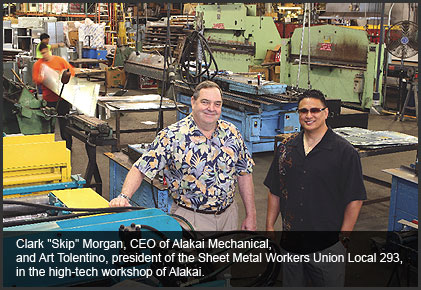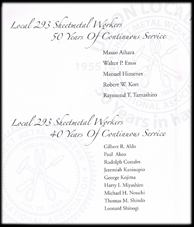Hawaii Sheet Metal Workers Training Fund 1(808)841-6106
HSMW In The News
 Labor of Love
Labor of Love
February 2009 Hawawii Business
Clark “Skip” Morgan, the CEO of Alakai Mechanical, was sitting at his desk not long ago, casually discussing his company’s growth, when, without a trace of irony, he said something astonishing: “A big part of our success, of course, is the union.”
To anyone familiar with the tumultuous history of labor relations in Hawaii — a history studded with characters like Jack Hall, Walter Kupau, and Art and Tony Rutledge, men whose names still rankle many in the business community — Morgan’s off-hand remark is a clear indication of the changing relationship between unions and island employers. The unions, themselves, are largely responsible for the change. As island businesses (and island jobs) have become more and more vulnerable to the competition created by new technologies and globalization, unions — particularly trade unions — have shouldered much of the responsibility for keeping up.
A big part is training. To keep up with changing technology, unions have increasingly focused on educating their members. Even a field like sheet metal work, which not too long ago was decidedly low-tech, is now dominated by computers and complex machinery. The success of companies like Alakai Mechanical depends on having an educated work force. “These guys, they may be walking around in dirty T-shirts and jeans, but they really know what they’re doing,” Morgan says. “And that’s because the union training here is outstanding.”
Education is clearly a major focus for Art Tolentino, president of the Sheet Metal Workers Union Local 293, which supplies most of the skilled labor for Alakai. For sheet metal apprentices, a five-year member training program, run through Honolulu Community College, covers everything from union history to safety to computer skills. Under Tolentino, the union has invested heavily in the kind of advanced equipment that the sheet metal worker is likely to see on the job: the big plasma cutters, fabrication machines and computer software, which have largely replaced tin shears and the drafting board. “What we studied 20 years ago cannot sustain us,” Tolentino says. “People like Skip [Morgan] at Alakai are big on getting the newest tools that will save labor. Our job is to train our members.”
Education is just one example of the unions’ growing level of partnership with management. “As far as business is concerned,” Tolentino notes, “we realize that we’re in business together, that there’s a common goal.”
Morgan echoes that sentiment. “I remember the ‘good old days,’ when it got kinda rough,” he says. “But the relationship is much more sophisticated today. Now, everybody realizes we’re in the same boat.”
Kalani Mahoe, district representative of the Operating Engineers Local Union 3, puts it another way. “You can have a company without a union, but you can’t have a union without a company,” he says.
Like Tolentino, Mahoe is committed to education, and he points out that Local 3 runs a 116-acre training facility in Kahuku. “I’ve got just under $11 million in equipment: cranes, loaders, dozers, skids, scrapers, trucks — you name them, I’ve got them all,” he says. Also like Tolentino, Mahoe sees training as the union’s role in a growing partnership with management. It’s an ethic enshrined right in the union’s mission statement, which begins:
“Local 3 is committed to providing our employers and agencies with the highest skilled union members..."
“Ten years ago,” Mahoe says, “the union thought all they were supposed to do was fight — let the employers take care of their profits. But we have a lot of competition now from non-union contractors and I think labor and management need to work much more closely. The relationship needs to develop so it’s like a marriage.”
The changing relationship between business and labor inevitably reflects a change in union leadership. Perhaps no one has had a more comprehensive a view of this change than Timothy Ho, president and CEO of the Hawaii Employers Council, an organization that handles labor negotiations for nearly 200 companies. To Ho, the most dramatic change in Hawaii unions has been the growing level of professionalism at the top. “There’s not as much saber-rattling or fist-pounding these days,” he says. “I would have to say that union leadership has become a lot more sophisticated.” And he doesn’t think that sophistication is an accident; it’s the result of coordinated efforts at both the local and national level. “In the past, it was sort of an on-the-job training thing. Now, I believe they go to class and there’s a curriculum for them.”
Randy Perreira, executive director of the Hawaii Government Employees Association, which, with nearly 44,000 members, is the state’s largest union, agrees with Ho. “Our national union, AFSCME, has really stepped up its efforts,” he points out. “We have far more comprehensive training than was available in the past. We even have on-line classes, so you don’t have to show up physically someplace.” He also notes that much of the training nowadays is increasingly about how to run a large organization. “They offer training for individuals who are new at the administrative process. It goes over less how to be a union man than how to run a business.”
Naturally, all that training and sophistication have affected labor negotiations. To begin, it has injected a greater level of objectivity into the process. On the one hand, that means more emphasis on gathering information. “We don’t enter into the process without careful consideration of the employers’ ability to pay,” says Perreira. In HGEA’s case, that means delving into the arcana of government budgets and programs. “We don’t have an economist on staff, but we’ll engage an economist if negotiations are bogging down.”
In the end, unions are increasingly realistic about what’s possible. “I think that’s a key element,” Perreira says. “Employees may deserve more —in fact, we believe the employees are worth a hell of a lot more than they get paid —and yet, there are economic limits that we have to live with.” Even Wayne Cahill, chief administrator of the Hawaii Newspaper Guild, and in many ways one of the state’s most old-fashioned union leaders, allows that this sort of pragmatism is inevitable in contract negotiations. Though he may distrust management (“Gannett probably wrote the book on union-busting in this industry,” he says), he’s quick to note, “Obviously we’re not going to bargain any company out of business.”
Despite all the talk about change, some union leaders still believe in traditional unionism. Few, though, have as hardboiled a view as Cahill. “I think the struggle was the same in the 1930s as it is today,” he says. “Maybe we’re a little more civilized and we don’t use such earthy language, but I think it’s the same.” For traditionalists like Cahill, all the talk of change and partnership is beside the point; unionism is simply a counter to a basic flaw in human nature. “If a worker wants to go bargain for himself, the boss is going to tell him, ‘If you don’t like it, quit.’ It’s only by getting together and forming a union that the worker has a shot. And that’s what it was all about in the 1930s.”
Others, though they may not offer the same grim views as Cahill, are still traditionalists at heart. Nate Lum, chairman of the longshoremen’s unit of the ILWU, acknowledges there have been a lot of changes and improvements in the union, but he believes most of those changes are the result of good old-fashioned organizing. “I still believe that we’ve got to educate our young leaders,” Lum says. “It’s very positive for these guys. But they’ve got to go to grass roots classes — the basics. They’ve got to be in the trenches.” Even so, he acknowledges that even this kind of professional development is a change. “I never had that opportunity. They fricking just turned me loose,” he says.
Some of the other members of Lum’s young, motivated executive committee cast an even more skeptical eye on the putative professionalism of Hawaii’s union leaders. One member, Dustin Dawsun, excoriated the leadership of other unions for their high salaries: “I could be wrong, but I think a lot of guys got greedy and they forgot where they came from.” He points out that longshore leaders, like Lum, only work part-time for the union, and only get paid for lost time from their dock work. “We don’t get no salary of $100,000 here. It’s just for the love of the union.”
There’s no mistaking the fact, though, that most of those union leaders have given up jobs as carpenters, machinery operators and laborers to run large, increasingly complicated organizations. They conduct tense, complex negotiations. Some of them manage a staff of thousands. (Or, as one leader put it, “I have thousands of bosses.”) In that light, it’s not surprising that today’s union leaders should view themselves as partners with Hawaii businesses. After all, as Art Tolentino explains, “Running a union, itself, has changed into running a business. Unions are businesses now that have a membership. The faster you realize that, the better it will all work out in the end.”

